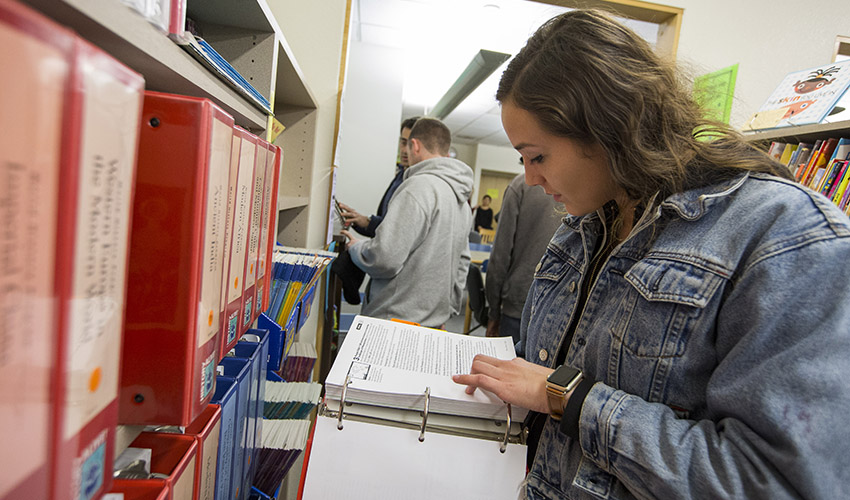SF State tackles the public school teacher shortfall

Graduate College of Education student Emily Rodriguez explores resources in the Cahill Learning Lab.
The Graduate College of Education offers innovative solutions to help fill the gap
California has a serious teacher shortage in its public schools. The ratio of students to teachers is now about 30 to one, according to the California Department of Education, and the number of credentialed teachers coming from the state’s colleges and universities is not keeping up, with approximately 10,500 graduating annually to fill nearly 20,000 openings. For comparison, the latest numbers from the National Center for Education Statistics indicate that the national ratio of students to teachers was 16 to 1 in 2013.
“In recent years, the state has been facing an increasing shortage, projected at about 10,000 credentialed teachers for the coming year,” said Robert Williams, associate dean of San Francisco State University's Graduate College of Education.
And with California’s population becoming increasingly ethnically diverse, there is an urgent need for more teachers who represent that diversity. For example, the California Department of Education reported that in the 2016–2017 school year, Hispanic students represented 54 percent of the school enrollment while only 20 percent of teachers were Hispanic. Research studies have documented positive academic effects from having teachers of diverse ethnic backgrounds that reflect the diversity of the students.
The Graduate College of Education is addressing these challenges head-on. With a grant from the California State University (CSU) chancellor’s office the college is reaching out to high school students in underrepresented groups in the Bay Area as part of its Building Bridges for Educator Equity program. “We want students of color — African Americans, Asian Pacific Islanders, Latinos — to be able to see teachers like them in front of them. I want people who are out as LGBT in front of students so students can see themselves in that teacher, and people with disabilities who are open about it, so that students with disabilities can see themselves in that teacher,” said Williams. Other initiatives include:
- A CSU-San Francisco State partnership with the Parent Institute for Quality Education in local school districts, offering parents from underrepresented groups a nine-week workshop to learn about university admission requirements
- Step-to-College, an outreach program to recruit 300 to 500 high school students each year to complete up to six college credits and prepare to transition from high school to college
- Transfer Articulation Bridge, founded over 30 years ago with City College of San Francisco and expanded to Skyline College to help underrepresented students successfully transfer to San Francisco State
- A partnership with San Francisco State’s Metro Academies College Success Program to develop more teachers through its teacher academy
- A collaboration with the San Francisco Unified School District and the San Mateo County Office of Education to improve teacher preparation in ongoing teacher pipeline initiatives
- EduCorps and other recruitment events for San Francisco State students to explore careers in education
Nancy Robinson, interim dean of the Graduate College of Education, notes that California is one of the few states that has required prospective teachers to complete a bachelor’s degree in addition to a credential program. In 2016, SF State received two grants from the California Commission on Teacher Credentialing to create an integrated, four-year credential program. The funding is helping SF State develop a B.A. in kinesiology with an integrated credential in physical education and a B.A. in liberal studies or child and adolescent development with an integrated Multiple Subject Credential with the option of bilingual authorization.
Robinson says the college is invested in social justice and equity and building quality teachers. She stresses that financial assistance is available for students who want to give back to their communities by becoming a teacher. “We have many scholarship opportunities in this college. There is money to help students continue their programs and to ease the financial costs,” she said.